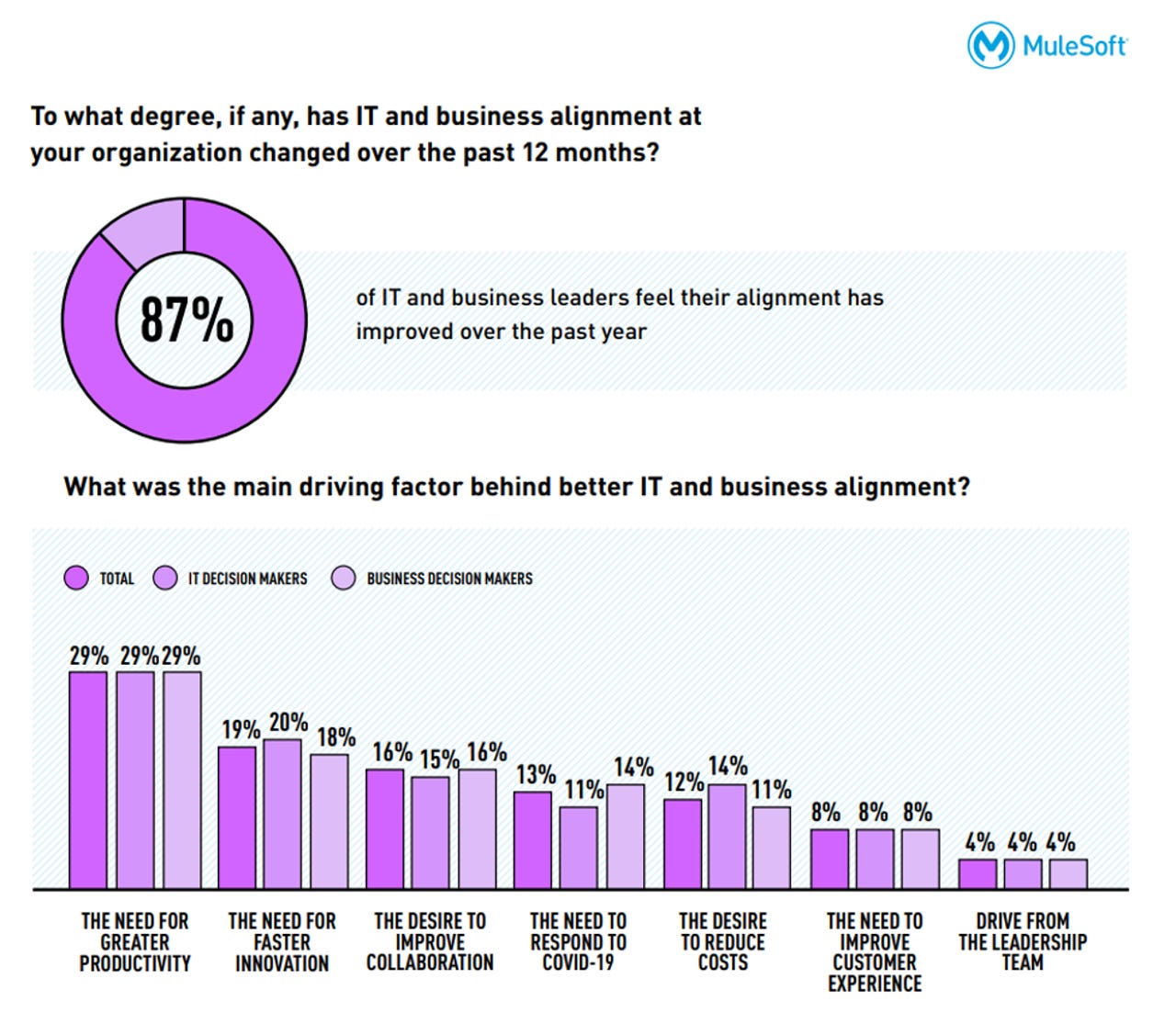IT and business alignment is key to successful digital transformation

MuleSoft, provider of the world's #1 integration and API platform, released the 2021 IT and business barometer report, highlighting four trends IT and business leaders need to know to deliver business outcomes faster, and together. The MuleSoft IT and business alignment barometer report, in partnership with Coleman Parkes Research, surveyed 2,400 IT and business decision makers across the globe regarding their business priorities over the next 12 months and the technological and operational challenges they face making them a reality. Respondents were all IT decision or business decision makers -- those who hold a managerial position or above. All respondents work at an organization in the public or private sector with at least 1,000 employees.
The report notes: "The pace of digitization has undoubtedly accelerated over the last 12-18 months. As a result, many CIOs and IT leaders are now leading their organizations through the change by solving critical operational issues and driving innovation faster. But for organizations that want to do more than just survive, IT and business teams must prioritize mutual collaboration to grow and scale innovation."
When IT and business teams align and collaborate in new ways through integration and automation, companies find that they can innovate at scale and deliver more connected products and services than ever before. Here are the four key trends in Mulesoft's IT and business alignment barometer report:
- IT and business teams get closer. Over the past year, IT and business have aligned even more closely due to the need for greater operational efficiency, increased productivity, and faster innovation. By reducing/eliminating organization silos, companies can reduce time to market and quickly create innovative, connected customer experiences. Almost 9 in 10 respondents report improvements in IT-business alignment.
- Automation powers business priorities. Automation has become a big focus as organizations look to realize their strategic goals. Most organizations have implemented or are in the process of implementing automation initiatives to improve productivity (96%), operational efficiency (93%), and create better-connected customer experiences (93%).
- Integration tops IT and business agenda. Organizations that empower their business teams with no-code tools to complete projects on their own benefit from increased speed and innovation. Most (86%) of respondents believe empowering business users to create connected experiences themselves would improve business outcomes.
- Tech challenges hindering business outcomes. IT and business decision makers agree that integration, data security, and automation challenges are holding them back from meeting their organization's business priorities. A strong majority of IT and business leaders (87%) are concerned that security and governance are slowing the pace of innovation.
Here are the 8 key takeaways from the report:
IT and business teams get closer
IT and business alignment has improved for the majority of organizations (87%) over the past 12 months -- 43% say it has improved significantly. According to the report, "COVID-19 has sparked a new focus on business agility. More than three-quarters (78%) of organizations say improving business agility is extremely important to remain competitive in the future."
- Stronger IT and business alignment is key to success. As businesses work to obtain their footing in a changing world, most (87%) IT and business leaders feel their alignment has improved over the past year.

IT and business are on the same page
2. Better IT and business alignment yields benefits The improved IT and business alignment has resulted in several benefits, including improved collaboration (64%), improved operational efficiency (58%), and better customer experience (54%).
The improved IT and business alignment has resulted in several benefits
3. IT takes center stage for driving digital business transformation and innovation. With the acceleration of digital transformation over the last 12 months, most (88%) respondents believe that IT has become even more important to driving business outcomes -- almost half (48%) claim "significantly" so. In addition business agility is in the forefront of driving digital transformation. The report notes: "Because of the rapid changes brought by the pandemic, businesses value agility more than ever. Over three-quarters (78%) of organizations say improving business agility to remain competitive will be extremely important in the future, versus 68% pre-pandemic."
Top CIO/IT technology investments:
— Vala Afshar (@ValaAfshar) February 10, 2021
1. Security
2. Big data and analytics
3. Internet of things
4. Multi-cloud strategy
5. AI /Machine Learning
6. Blockchain
7. Streaming big data
8. Microservices
9. Virtual/Augmented Reality
10. API monetization https://t.co/n2KCOyLdFW pic.twitter.com/1WlRY2iIm8
Automation powers business priorities
The main business priorities for organizations over the coming year will be:
- Enhancing operational efficiency
- Creating better connected customer experiences
- Improving productivity
- Becoming more agile and data-driven
4. Digital innovation velocity (speed and direction) is at breakneck pace, requiring focus and urgency. With the pace of digital change showing no sign of slowing down, global organizations are being more strategic about their business priorities over the next 12 months. Their top five business priorities for the coming year are:
- Improving operational efficiency (54%)
- Creating better connected customer experiences (50%)
- Improving productivity (49%)
- Becoming more agile for change and adapting to market demands (48%)
- Becoming a more data-driven organization (45%)
Digital transformation is a top priority for business leaders and IT
5. Automation becomes business-critical. Many of these business priorities rely on automation. Most organizations have implemented, or are in the process of implementing, automation initiatives to improve:
- Operational efficiency (93%)
- Productivity (95%)
- Connected customer experiences (93%)
IT is driving automation. A majority (74%) of IT leaders believe that automation initiatives are IT-led (i.e., driven by the IT department and the technology available). Only 60% of business leaders believe that automation initiatives are IT-led, leaving 40% saying that initiatives are business-led (i.e., driven by the needs of the business to enhance processes).
15 BIG TECH 2021:
— Vala Afshar (@ValaAfshar) May 9, 2021
1 Deep Learning (AI)
2 Virtual Worlds (Gaming and AR/VR)
3 Digital Wallets
4 Bitcoin Fundamentals
5 Electric Vehicles (EVs)
6 Automation
7 Autonomous Ride-Hailing
8 Delivery Drones
9 Orbital Aerospace
10 3D Printing
11 Cancer Screening https://t.co/BGr8sItQzh pic.twitter.com/gIIphmNa2M
Tech challenges hindering business outcomes
The report identifies two key challenges for IT in order to drive better business outcomes. Integration is the first challenge, preventing organizations from realizing their top five priorities over the next 12 months. Automation is also hindered by security concerns, data silos, and a lack of business process, technology, and integration skills.
6. Integration issues continue to hinder business success. Business and IT leaders agree that integration challenges prevent them from achieving their top five business priorities. With an increasing number of systems, applications, and data sources to integrate, there are understandably growing concerns around data security and governance. Nearly three-quarters (73%) of respondents say concerns have increased, with almost a third (31%) of organizations saying they have "significantly" increased.
A strong majority of IT and business leaders (87%) are concerned that security and governance are slowing the pace of innovation. Data security and governance concerns aren't only impacting the pace of innovation. Most organizations (87%) feel they're also preventing non-technical users from being empowered to integrate data.
Only 37% of IT teams were able to complete all the projects asked of them in 2020.
— Vala Afshar (@ValaAfshar) June 15, 2021
IT is being asked to deliver on 30% more projects in 2021, while their budgets are only expected to grow by just under 6%.
2021 research identifies key CIO investments https://t.co/llEZSuQANb
7. Multiple barriers to automation exist today. Numerous research points to the fact that automation is key to accelerating digital transformation. Automation has become a big focus and a key approach to achieve business outcomes, but the journey is far from easy. Organizations highlighted the following barriers to automation success:
- Data security and governance concerns (74%)
- A lack of business process skills (73%)
- An absence of technology and integration skills (72%)
- Data silos (71%)
Multiple barrier to automation
Integration tops IT and business agenda
The report found that integration is on the business agenda -- the vast majority of organizations (91%) believe integration can accelerate the speed and efficiency of the business and IT. A majority (86%) of respondents support low or no-code approaches to create connected experiences* and improve business outcomes.
8. Improved integration accelerates business outcomes. Most (91%) business decision makers understand how integration can enable business teams to carry out tasks faster (e.g., streamline cash-to-order processes) and deliver new services faster (e.g., build new eCommerce platforms). Most (89%) IT and business decision makers agree that reusable building blocks like APIs make the whole process of stitching together disparate systems, apps, and data far easier.
9. No-code/low-code application development improves business outcomes. Some 86% of respondents believe that if low- or no-code approaches were made available to business users, they could create connected experiences themselves to improve outcomes. A third (38%) believe it would "significantly" improve business outcomes. The report found that low-code or no-code usage would deliver these top 3 business outcomes: 1. improved productivity, 2. become a data-driven organization and 3. improved operational efficiency.
The business benefits of low-code or no-code application development
Mulesoft's IT and business alignment barometer report shows that IT and business leaders are working closer together to drive better business outcomes. The report concludes with these four recommendations for IT and business leaders:
- Composability. API-led connectivity means faster time-to-market, less effort for IT, and reduced costs. The cost savings made from harnessing reusable approaches will only grow over time and can be reinvested into the organization to drive future innovation and growth.
- Empowering all business users. Reusable APIs can take much of the pressure off IT. But with drag-and-drop functionality for development, you can truly put the power to create into the hands of business users. That means closer IT-business alignment and faster outcomes for the business. It's a win-win.
- Central foundation of governance. A serious breach could have major financial and reputational repercussions and set back digital transformation efforts. A central foundation of governance in one unified platform is far more sustainable and scalable as the IT department looks to centrally establish, apply, and enforce its policies and best practices through a "single pane of glass."
- A single house, multiple windows. A central foundation of governance requires agility so that each user, regardless of their profile, can access and understand the information relevant to them. Having the ability to create tailored views of that one unified platform is key to keeping all teams on the same page.
To learn more about the IT and business alignment barometer report, you can visit here.